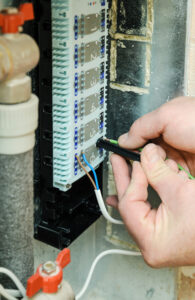In manufacturing and automation processes, there are multiple pieces of machinery that ensure the operation is being performed correctly and precisely, without deviation. These automated control systems are used in everything from the manufacture of cars on an assembly line to warehouse automation.
The motors that drive these systems use servos to take in and regulate the power that goes to the entire operation. A servo system requires four basic parts, although in some cases depending on size and need, there may be more parts, but rarely less.

Controller
The first component in a servo system is the controller, which performs two duties. The first is to track command input and the second is to improve the system’s disturbance rejection.
Servo Drive
The role of the servo drive is to take the command signals from the controller and then transform them from low power commands to higher power voltage and current to the motor.
Motor
The parts of a machine are rotated by the motor, which can be moved and adjusted according to what the process is built to achieve. The motor is a closed-loop mechanism which controls the rotational speed and position.
Load
This term is used to describe the combination of the inertia, mass, viscous damping, and torsional stiffness. This system consists of a DC-motor reduction gear, an output sensor, and a microcomputer that makes constant calculations for adjustment.
The Role of the Servo Drive
The servo drive’s role in an automated controls system is regulating the powering of the servo motor. Once the drive has sent the power to the motor, it continues to regulate and properly coordinate the motor’s position, speed, torque, and other actions.
An automatic control system – also known as a closed loop system – is regulated by feedback. In this case the feedback is generated by the motor’s performance and then closely monitored by the servo drive.
The accuracy and dependability of the servo drive makes it a vital piece of machinery in several different areas of operation. For instance, a servo drive can help position a globe valve so that it’s in the right position to function properly.
Mechanical Problems
Like any other component or piece of machinery, a servo drive’s output and performance can decline over a period of time. Besides the regular wear and tear, the drive can be damaged by the buildup of dirt and grime, intense swings in temperature, and improper installation.
ACS Can Repair Your Servo Drive
Despite making sure the inverter drive is installed properly and maintained, breakage can occur and the power source’s output might not be regulated. This can cause multiple problems throughout the system.
If you’re considering whether to repair your servo drive, choose ACS and let us give you a free evaluation and repair quote.
- Repair usually saves up to 80% the cost of buying a new piece of equipment.
- Most repairs are back in your hands in 7-15 days after approval.
- Our Rush Repair Service ships in just 2-5 days after approval.
- We Guarantee Our Repairs With A Full Two-Year Warranty .
For a Free Evaluation, use our RMA Form link or visit our website and click on the “Contact Us” button on the upper right hand. You can also reach out to us at 800-605-6419 and speak to someone on our customer support team.
